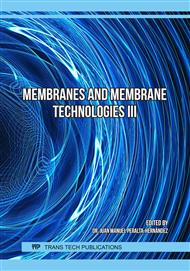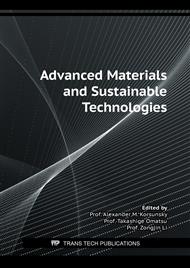[1]
R. K. Gautam, S. K. Sharma, S. Mahiya, and M. C. Chattopadhyaya, CHAPTER 1. Contamination of Heavy Metals in Aquatic Media: Transport, Toxicity and Technologies for Remediation,, in Heavy Metals In Water, (2014).
DOI: 10.1039/9781782620174-00001
Google Scholar
[2]
B. Yang, Y. Wei, Q. Liu, Y. Luo, S. Qiu, and Z. Shi, Polyvinylpyrrolidone functionalized magnetic graphene-based composites for highly efficient removal of lead from wastewater,, Colloids Surfaces A Physicochem. Eng. Asp., vol. 582, no. July, p.123927, 2019,.
DOI: 10.1016/j.colsurfa.2019.123927
Google Scholar
[3]
B. Lellis, C. Z. Fávaro-Polonio, J. A. Pamphile, and J. C. Polonio, Effects of textile dyes on health and the environment and bioremediation potential of living organisms,, Biotechnol. Res. Innov., vol. 3, no. 2, p.275–290, 2019,.
DOI: 10.1016/j.biori.2019.09.001
Google Scholar
[4]
M. T. Yagub, T. K. Sen, S. Afroze, and H. M. Ang, Dye and its removal from aqueous solution by adsorption: A review,, Adv. Colloid Interface Sci., vol. 209, p.172–184, 2014,.
DOI: 10.1016/j.cis.2014.04.002
Google Scholar
[5]
R. Mulyanti and H. Susanto, Wastewater treatment by nanofiltration membranes,, IOP Conf. Ser. Earth Environ. Sci., vol. 142, no. 1, 2018,.
DOI: 10.1088/1755-1315/142/1/012017
Google Scholar
[6]
B. Van Der Bruggen and C. Vandecasteele, Removal of pollutants from surface water and groundwater by nanofiltration: Overview of possible applications in the drinking water industry,, Environ. Pollut., vol. 122, no. 3, p.435–445, 2003,.
DOI: 10.1016/s0269-7491(02)00308-1
Google Scholar
[7]
D. Karisma, G. Febrianto, and D. Mangindaan, Removal of dyes from textile wastewater by using nanofiltration polyetherimide membrane,, IOP Conf. Ser. Earth Environ. Sci., vol. 109, no. 1, 2018,.
DOI: 10.1088/1755-1315/109/1/012012
Google Scholar
[8]
J. T. Jung, J. F. Kim, H. H. Wang, E. di Nicolo, E. Drioli, and Y. M. Lee, Understanding the non-solvent induced phase separation (NIPS) effect during the fabrication of microporous PVDF membranes via thermally induced phase separation (TIPS),, J. Memb. Sci., vol. 514, p.250–263, 2016,.
DOI: 10.1016/j.memsci.2016.04.069
Google Scholar
[9]
A. Sutedja, C. A. Josephine, and D. Mangindaan, Polysulfone thin film composite nanofiltration membranes for removal of textile dyes wastewater,, IOP Conf. Ser. Earth Environ. Sci., vol. 109, no. 1, 2018,.
DOI: 10.1088/1755-1315/109/1/012042
Google Scholar
[10]
G. Febrianto, D. Karisma, and D. Mangindaan, Polyetherimide nanofiltration membranes modified by interfacial polymerization for treatment of textile dyes wastewater,, IOP Conf. Ser. Mater. Sci. Eng., vol. 622, no. 1, 2019,.
DOI: 10.1088/1757-899x/622/1/012019
Google Scholar
[11]
A. E. Abdelhamid, A. A. El-Sayed, and A. M. Khalil, Polysulfone nanofiltration membranes enriched with functionalized graphene oxide for dye removal from wastewater,, J. Polym. Eng., vol. 40, no. 10, p.833–841, 2020,.
DOI: 10.1515/polyeng-2020-0141
Google Scholar
[12]
K. Li and Z. Xu, Decomposition of high-impact polystyrene resin in e-waste by supercritical water oxidation process with debromination of decabromodiphenyl ethane and recovery of antimony trioxide simultaneously,, J. Hazard. Mater., vol. 402, no. August 2020, p.123684, 2021,.
DOI: 10.1016/j.jhazmat.2020.123684
Google Scholar
[13]
H. El Bhilat, A. Hachim, H. Salmi, H. Mabchour, and K. El Had, Characterization and processability of post-consumer, double-recycled high impact polystyrene from disposable cups,, Mater. Today Proc., vol. 45, p.7264–7270, 2021,.
DOI: 10.1016/j.matpr.2020.12.935
Google Scholar
[14]
S. Shojaei, S. Shojaei, S. S. Band, A. A. K. Farizhandi, M. Ghoroqi, and A. Mosavi, Application of Taguchi method and response surface methodology into the removal of malachite green and auramine-O by NaX nanozeolites,, Sci. Rep., vol. 11, no. 1, p.1–13, 2021,.
DOI: 10.1038/s41598-021-95649-5
Google Scholar
[15]
S. Salem and A. Salem, A novel design for clean and economical manufacturing new nano-porous zeolite based adsorbent by alkali cement kiln dust for lead uptake from wastewater,, J. Clean. Prod., vol. 143, p.440–451, 2017,.
DOI: 10.1016/j.jclepro.2016.12.091
Google Scholar
[16]
M. Mecozzi, M. Pietroletti, M. Scarpiniti, R. Acquistucci, and M. E. Conti, Monitoring of marine mucilage formation in Italian seas investigated by infrared spectroscopy and independent component analysis,, Environ. Monit. Assess., vol. 184, no. 10, p.6025–6036, 2012,.
DOI: 10.1007/s10661-011-2400-4
Google Scholar
[17]
H. Nofitri Da Conceicao Isya, I. Valadares Marcal, and R. R. Aquino, Fabrication and Characterization of PVDF with an Additive of Nanozeolite via Electrospinning and Non-solvent Induced Phase Separation (NIPS) Process,, MATEC Web Conf., vol. 319, p.10002, 2020,.
DOI: 10.1051/matecconf/202031910002
Google Scholar
[18]
S. Hamzah et al., Synthesis, characterisation and evaluation on the performance of ferrofluid for microplastic removal from synthetic and actual wastewater,, J. Environ. Chem. Eng., vol. 9, no. 5, p.105894, 2021,.
Google Scholar
[19]
S. Homaeigohar, The nanosized dye adsorbents for water treatment,, Nanomaterials, vol. 10, no. 2, 2020,.
Google Scholar
[20]
M. A. Ahmad, N. B. Ahmed, K. A. Adegoke, and O. S. Bello, Sorption studies of methyl red dye removal using lemon grass (Cymbopogon citratus),, Chem. Data Collect., vol. 22, Aug. 2019,.
DOI: 10.1016/j.cdc.2019.100249
Google Scholar





